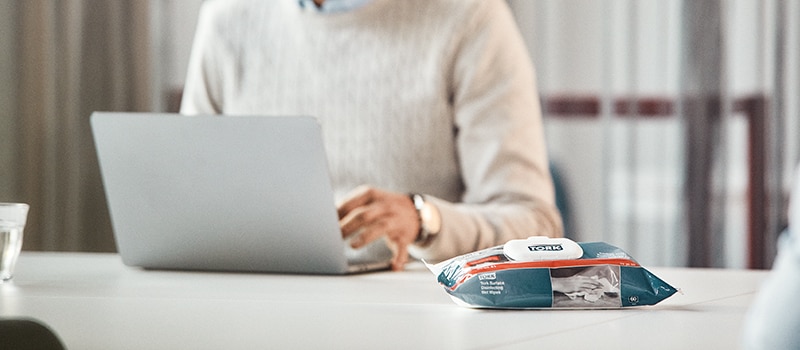
How to clean an office - from floors to desk cleaning
Knowing the best way to approach office cleaning can be difficult. Finding the right approach for your office can depend on several office cleaning requirements, like the size of the space and the daily footfall. However, some office cleaning elements apply across all workplaces. These include a consistent cleaning routine, deep cleaning, and knowing the right level of cleaning needed for your building.
The benefits of a clean office
Improving hygiene levels at your office can be surprisingly simple and comes with various benefits.
- Hygiene, health, and well-being are closely connected. In fact, 86% of employees regard cleanliness as the most important aspect of a good work environment*.
- Good hygiene practices help cut the risk of illness, meaning you and your employees are likely to have less time off - improving efficiency.
- A clean and hygienic workplace positively impacts how others view your business.
How to perform routine cleaning
Routine cleaning ideas
Routine cleaning consists of a few core cleaning practices such as:
Clear dust and dirt
Routine cleaning includes activities like vacuuming and dusting surfaces.
Refill dispensers
Restock paper hand towels, soap and toilet paper.
Check personal hygiene stations
Restocking sanitizing stations helps to make sure employees are able to practice proper hand hygiene. Tork Skincare dispensers can be easily refilled in less than 10 seconds*, saving cleaning staff valuable time that can be used for other tasks. This lets your employees reduce cleaning time while still prioritizing hygiene.
Care for accessories
We often think about the risk of infection from surfaces, but rarely extend this to the items we put on them. We spend a lot of time at our office desks, so making sure that cleaning staff remove germs on surfaces, as well as the equipment on them, is vital to everyone’s personal hygiene.
Many offices today have clean desk policies. Especially common in open plan offices, flexible offices etc. Then nothing is left on the desks, make it easier for cleaning staff to clean.
Use the correct products
Proper cleaning utilizes equipment such as disinfectant wipes, microfiber cloths, and sanitizers, which can allow your team to clean more efficiently and remove harmful bacteria from surfaces. Cleaning products are also used to combat aesthetic issues, such as helping to fight stubborn stains, as well as hygienic ones.
How to perform deep cleaning
Deep cleaning ideas
Consider introducing some more intensive cleaning processes into cleaning routines. Some of these cleaning activities may become a part of your routine daily cleaning. As with our routine cleaning ideas, this is not an exhaustive list, and the specific cleaning your workplace needs will depend on the space. Office deep cleaning processes might include:
Disinfect surfaces and floors
Disinfectants can be particularly effective in achieving a deeper level of cleaning. Due to the chemicals in these products, always make sure cleaning staff follow instructions on the product exactly. Also, understand the differences between cleaning, sanitizing, and disinfecting to help customers and cleaning staff learn what products are needed for different situations.
Clean normally inaccessible areas
Make sure to properly utilize the deep cleaning time available to focus on spaces that are busy or unavailable during normal working hours. This is particularly essential if there is no routine cleaning process after working hours. This is because high-touch surfaces such as desks and eating surfaces are more likely to be contaminated.
Reorganize the space
Try to create a space that encourages as little travel time for your team as possible between areas where contaminants will be carried back and forth, such as from fridge to counter. Creating spaces with a logical and easily accessible flow can help prevent hygiene hazards as well as a good logic and labelling in storage areas to help minimize time searching for supplies.
Create an office cleaning checklist
A cleaning checklist helps to create a consistent cleaning routine for your staff. It can demonstrate things like:
- How often routine cleaning should take place, as well as when a deep clean is necessary. This should include any daily office cleaning.
- The specific areas that need cleaning, broken down into a helpful order. Creating a map or list showing what type of cleaning is required per area may also be beneficial. Color coding can be useful too.
- A list of who is assigned to different tasks and what they are responsible for.
- As with all guides, it's important to adapt them as needed. For instance, it may become obvious that an extra routine clean would be useful in a particularly busy week with many visitors.
Find the optimum cleaning routine
Your office cleaning needs will vary depending on the footfall and size of your space. Real-time data can help you identify when and where there are cleaning needs in your facility. Tork Vision Cleaning, the world's leading data-driven cleaning solution , enables a more efficient way of working. Using data to optimize cleaning can save up to 20% of cleaning hours that can then be dedicated to other critical task**.
Elevate hygiene across your whole facility
Promote hygiene in every part of the office with the Tork Office Hygiene Package™. These include reception, meeting rooms, office areas, conference rooms, restrooms and breakrooms. It contains everything you need to meet maintain high cleaning quality and hygiene, which in turn helps improve employee workplace satisfaction.
References
* Office Insight Quantitative Research July 2022
** Based on the documented results achieved by three Tork Vision Cleaning customers, measured before and after the implementation of Tork Vision Cleaning. Tork Vision Cleaning was formerly known as Tork EasyCube.